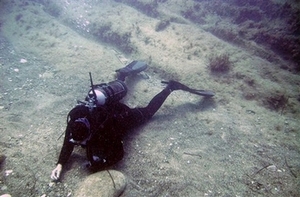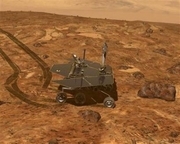George Psyllides, Associated Press Writer
Yahoo NewsSat, 21 Jul 2007 10:05 UTC
AKAMAS, Cyprus - Archaeologists excavating the seabed off Cyprus have discovered the tools of ancient mariners, which they believe were used by foragers more than 10,000 years ago - before the island had permanent settlements.

|
| ©AP
|
| A diver searches the Aspros area for ancient artifacts off the western coast of Cyprus
|
Thailand will have a close encounter with an asteroid expected to move closer to the Earth than the moon in the next 29 years, according to a prominent astronomer Worawit Tanwutthibundit. The asteroid, named 99942 Apophis, will come into close orbit with the Earth 22 years from now and it will come by again, even closer, seven years after that.
This has sparked fears over the possibility that it could collide with the Earth.
Tony Long
WiredSat, 21 Jul 2007 05:46 UTC
1862: American astronomer Lewis Swift discovers the presence of a large comet that will soon bear his name. Three days later, another American astronomer, Horace Tuttle, makes the same sighting. So this heavenly body comes down to us as the Comet Swift-Tuttle.
Based on their observations, and those of other astronomers who began tracking the comet's highly elongated orbit, it was calculated that Swift-Tuttle would make its next appearance during the 1980s. They were close. Japanese astronomer Tsuruhiko Kiuchi rediscovered the comet in 1992.
The University of Arizona-based High Resolution Imaging Experiment (HiRISE) group this week released a good look at a dust devil on Mars. This is not the storm bedeviling NASA's Mars Exploration Rovers, Spirit and Opportunity.
The HiRISE camera captured the dust twister by chance in its photographic swath of a region in the southern hemisphere near Hellas Planitia during a Martian mid-afternoon early last month. The HiRISE camera is orbiting the Red Planet on NASA's Mars Reconnaissance Orbiter.
Geology detectives in Saskatchewan might have made two important discoveries this summer.
And, as it usually happens for members of the multi-university partnership Prairie Meteorite Search, the finds have come from unexpected places.
When farmer Ken Wiggins heard that field researcher Nathan Seon was coming to talk about meteorites with locals near Wiggins' home base of Manor, he figured there wasn't any harm in having Seon examine an odd-shaped depression that had been on the farm as long as anyone could remember.
NASASat, 21 Jul 2007 03:10 UTC
Scientists have recently discovered that the planet Saturn is turning 60 - not years, but moons.
"We detected the 60th moon orbiting Saturn using the Cassini spacecraft's powerful wide-angle camera," said Carl Murray, a Cassini imaging team scientist from Queen Mary, University of London. "I was looking at images of the region near the Saturnian moons Methone and Pallene and something caught my eye."
The newly discovered moon first appeared as a very faint dot in a series of images Cassini took of the Saturnian ring system on May 30 of this year. After the initial detection, Murray and fellow Cassini imaging scientists played interplanetary detective, searching for clues of the new moon in the voluminous library of Cassini images to date.
The Cassini imaging team's legwork paid off. They were able to locate numerous additional detections, spanning from June 2004 to June 2007. "With these new data sets we were able to establish a good orbit for the new moon," said Murray. "Knowing where the moons are at all times is important to the Cassini mission for several reasons."
Comment: Congratulations, Saturn. You've just got your new comet...eh, moon.
From:
Forget About Global Warming: We're One Step From Extinction!Now let's time travel back to the future, and see what the
latest information tells us about Jupiter's moons:
Jupiter is now given 63 satellites. Forty-seven of those satellites have been discovered since 1999. What if they weren't there before?
What about Saturn. Our 1975 text tells us that Saturn has 10 satellites. In 2007? Well, there are so many that
one source declines to give a precise number!
However, counting the named satellites on the
Timeline of discovery of solar system planets and their natural satellites gives us a count of 62, with 41 being discovered since 2000 and another ten in the 80's and 90's.
Moving outward, we come to Uranus, given five satellites in 1975, it now has 28, with ten being discovered in the 1980's, six in the 90's, and 7 since 2000.
Neptune had two satellites in 1975, now it has 13.
| Planet
|
1975
|
2005
|
Jupiter
|
9
|
63
|
Saturn
|
10
|
62
|
Uranus
|
5
|
28
|
Neptune
|
2
|
13
|
Table 1. Number of moons The explanation given most often to explain this surge in the numbers of satellites for these planets is that telescopes have gotten better. That is, we can see further, with greater detail, and can therefore find things that we couldn't see before. It is an explanation that makes sense. One small problem with this theory is that the "new" moons of Neptune and Uranus showed up before the new moons of Jupiter and Saturn. One would think that powerful telescopes capable of finding moons as far away as the seventh and eighth planets would have found the hard to see moons of the fifth and sixth first.
Another possible explanation, and one which fits with new moons appearing around Neptune and Uranus prior to appearing around Jupiter and Saturn, is that these new moons, or some of them, are objects that have been trapped into orbits around these planets only recently, that they were captured by the gravity of these planets and removed from the incoming comet cloud. Passing the orbits of the outer planets first, they would arrive at the inner planets afterward.
We also note that the much derided Immanuel Velikovsky, in his book
Worlds in Collision, gives a time frame of nine years as the time it would take for a comet to cover the distance between Jupiter and Earth. The new Jovian moons were discovered beginning in the late nineties.
Do the math.
Will Dunham
ReutersSat, 21 Jul 2007 01:26 UTC
A dust storm raging on Mars presents the worst threat to date to the continued operation of NASA's two rovers, threatening to starve the solar-powered robots by blocking out sunlight, NASA said on Friday.
The little, six-wheeled rovers, Opportunity and Spirit, are operating at two distant sites just south of the Martian equator. The large regional dust storm that has lasted almost a month has been worse at Opportunity's locale, NASA said.

|
| ©Reuters
|
| An undated NASA illustration depicting one of two six-wheeled rovers operating on the surface of Mars.
|
Dave Mosher
Space.comSat, 07 Jul 2007 05:32 UTC
A giant dust storm that now covers nearly the entire southern hemisphere of Mars could permanently jeopardize the future of the Mars Exploration Rovers mission, officials told SPACE.com today.
The new and potentially bleak outlook is a stark shift from the prognosis earlier this week. Further compounding the threat to the rovers, a second large dust storm has recently appeared on the Red Planet.
The first and largest dusty squall has reduced direct sunlight to Mars' surface by nearly 99 percent, an unprecedented threat for the solar-powered rovers. If the storm keeps up and thickens with even more dust, officials fear the rovers' batteries may empty and silence the robotic explorers forever.
"This is a scary storm," said Mark Lemmon, a planetary scientist at Texas A&M University and member of the rover team. "If it gets any worse, we'll enter into some uncharted territory. There's been a lot of discussion about what we're going to do if (the rovers) don't have enough power to run during the day."
A man with an unusually tiny brain managed to live an entirely normal life despite his condition, caused by a fluid buildup in his skull, French researchers reported on Thursday.
Scans of the 44-year-old man's brain showed that a huge fluid-filled chamber called a ventricle took up most of the room in his skull, leaving little more than a thin sheet of actual brain tissue.
"He was a married father of two children, and worked as a civil servant," Dr. Lionel Feuillet and colleagues at the Universite de la Mediterranee in Marseille wrote in a letter to the Lancet medical journal.
The man went to a hospital after he had mild weakness in his left leg. When Feuillet's staff took his medical history, they learned he had had a shunt inserted into his head to drain away hydrocephalus -- water on the brain -- as an infant.
Is your brain you really necessary? The reason for my apparently absurd question is the remarkable research conducted at the University of Sheffield by neurology professor the late Dr. John Lorber.
When Sheffield's campus doctor was treating one of the mathematics students for a minor ailment, he noticed that the student's head was a little larger than normal. The doctor referred the student to professor Lorber for further examination.



Comment: Congratulations, Saturn. You've just got your new comet...eh, moon.
From: Forget About Global Warming: We're One Step From Extinction!
Now let's time travel back to the future, and see what the latest information tells us about Jupiter's moons: What about Saturn. Our 1975 text tells us that Saturn has 10 satellites. In 2007? Well, there are so many that one source declines to give a precise number!
However, counting the named satellites on the Timeline of discovery of solar system planets and their natural satellites gives us a count of 62, with 41 being discovered since 2000 and another ten in the 80's and 90's.
Moving outward, we come to Uranus, given five satellites in 1975, it now has 28, with ten being discovered in the 1980's, six in the 90's, and 7 since 2000.
Neptune had two satellites in 1975, now it has 13.
Table 1. Number of moons
The explanation given most often to explain this surge in the numbers of satellites for these planets is that telescopes have gotten better. That is, we can see further, with greater detail, and can therefore find things that we couldn't see before. It is an explanation that makes sense. One small problem with this theory is that the "new" moons of Neptune and Uranus showed up before the new moons of Jupiter and Saturn. One would think that powerful telescopes capable of finding moons as far away as the seventh and eighth planets would have found the hard to see moons of the fifth and sixth first.
Another possible explanation, and one which fits with new moons appearing around Neptune and Uranus prior to appearing around Jupiter and Saturn, is that these new moons, or some of them, are objects that have been trapped into orbits around these planets only recently, that they were captured by the gravity of these planets and removed from the incoming comet cloud. Passing the orbits of the outer planets first, they would arrive at the inner planets afterward.
We also note that the much derided Immanuel Velikovsky, in his book Worlds in Collision, gives a time frame of nine years as the time it would take for a comet to cover the distance between Jupiter and Earth. The new Jovian moons were discovered beginning in the late nineties.
Do the math.